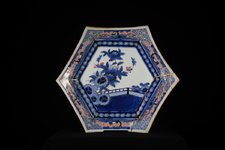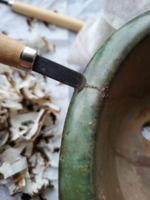lieuz
Chumono
Another pot on the path to repair is this Nick Lenz pot from a study group mate. Devastated it broke, I offered to repair it for him and he was very excited to have it put back together. Not going to sugarcoat this, this is going to be one hell of a fix because this is quite a larger repair and also there is a substantial amount of loss needing loss compensation to fill those damaged areas. Honored to repair a Lenz pot nonetheless.
Clean breaks, very little blow out of glaze so the glaze broke also very cleanly.

Nick Lenz chop. Seems to be a more recent pot of his, 3rd generation

Here is the pot put back together. Note the blow out on the inside. This will be easy to fill. I've noticed that I prefer the interior intact more than the exterior. There's more reason to show off the blow out vs having it hidden away, should the pot be used.

Note the very large piece missing. Part of the foot is also missing.

Side view of the more fragile side.

Missing piece. Will have to create a piece to fill in void.

And now we wait. Thanks for your time!
Thanks for your time!
Clean breaks, very little blow out of glaze so the glaze broke also very cleanly.

Nick Lenz chop. Seems to be a more recent pot of his, 3rd generation

Here is the pot put back together. Note the blow out on the inside. This will be easy to fill. I've noticed that I prefer the interior intact more than the exterior. There's more reason to show off the blow out vs having it hidden away, should the pot be used.

Note the very large piece missing. Part of the foot is also missing.

Side view of the more fragile side.

Missing piece. Will have to create a piece to fill in void.

And now we wait.



















































































